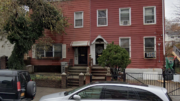Pretty soon, the Key Food at 325 Lafayette Avenue in Clinton Hill will be closing, to make way for an 110-unit apartment building developed by Slate Property Group. That will leave this slice of Clinton Hill without an easily accessible grocery store – something that is, understandably, upsetting to local residents and politicians.
The target of their ire is gentrification. “Supermarkets are an important part of the community. It’s an important amenity, especially for black and brown communities,” State Senator Velmanette Montgomery said at a town hall meeting. “When you’re talking about a white community, it can be a little boutique, because white people don’t eat the way we do.”
Sen. Montgomery’s bizarre race-baiting aside, she and others seem to be missing the root cause of central Clinton Hill’s impending lack of grocery stores: the zoning code simply doesn’t allow new ones.
Given Brooklyn’s density and the inherent redundancy that is – or should be – built into urban environments, the loss of one supermarket should not mean that residents won’t have easy access to groceries. But when the zoning code disallows retail in every single new building – the thatched areas in the map below are where retail is allowed, but nothing new has been built in them over the past few decades – it’s simply inevitable.

Zoning in Clinton Hill (Key Foods in pink, new retail allowed in thatched areas along Grand Avenue), image from ZoLa
There has been plenty of development outside of the commercial overlay zones, and some of the buildings even have footprints large enough to accommodate supermarkets. But city planners and City Council, in their infinite wisdom, have not deigned to allow any new retail on any developable sites. (Occasionally the parking requirements also compel developers to break their projects up into a number of smaller buildings to duck under the unit count at which parking is required, which makes the buildings too small for supermarket-sized stores, even if they were allowed.)
The 48-unit condo project at 315 Greene Avenue, for example, opened in 2010 with a roomy 192 feet of frontage, but no retail is allowed. And in any case, the project was broken up into six different buildings to avoid the city’s parking requirements.
Behind it, 136 Clifton Place has 79 feet of frontage, but no ground-floor retail is allowed there either. And again, the project was divided into four separate buildings, none of them large enough for a supermarket even if one were allowed.
The rental tower at 333 Greene Avenue has a solid 162 feet of continuous avenue frontage, and unlike the other buildings was not broken up. It even has what appears to a casual observer to be a storefront space perfect for a supermarket, with more than 17,000 square feet of floorspace – actually larger than the Key Food that’s set to disappear. But alas, without a commercial overlay, it can only be occupied by a community facility use, which does not include for-profit retail like grocery stores.
The list of large new buildings nearby that are not allowed to have supermarkets – 324 Grand Avenue (which sits just outside of the Grand Avenue commercial zone), 15-36 Quincy Street, 367 Classon Avenue – goes on, but I won’t bore you with the details.
But suffice it to say, Clinton Hill’s food desert issue has more to do with the zoning code’s resistance to allowing new retail in residential neighborhoods than it does with gentrification or white people not shopping at supermarkets. Ultimately it is City Planning and local politicians that are to blame for this impending crisis.
Talk about this topic on the YIMBY Forums
For any questions, comments, or feedback, email newyorkyimby@gmail.com
Subscribe to YIMBY’s daily e-mail
Follow YIMBYgram for real-time photo updates
Like YIMBY on Facebook
Follow YIMBY’s Twitter for the latest in YIMBYnews





